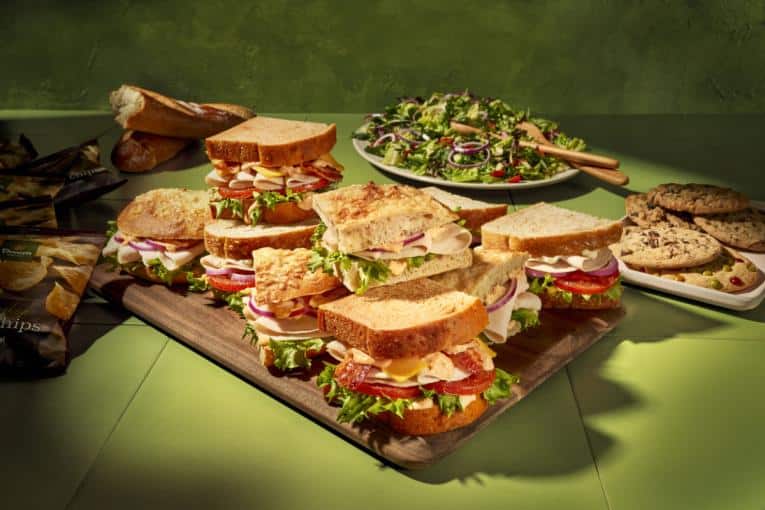Catering is becoming increasingly important to restaurants in today’s climate. According to Toast’s 2023 Voice of the Restaurant Industry Survey of 847 restaurant decision-makers, 48 percent of restaurant operators say it’s a top priority for the next 12 months, putting it on par with on-premises dining and delivery.
With the holiday season quickly approaching and many workers back in the office, this time of year is ripe to be one of the restaurant industry’s biggest catering opportunities. This busy season for office parties and private celebrations can unlock new opportunities to feed more mouths and grow a restaurant’s customer base and profits.
Given this large opportunity, growth-minded independent restaurant operators and regional chain managers should consider harnessing catering’s momentum this holiday season. Let’s look at four reasons why.
Reason No. 1. Revenue diversification
Catering diversifies holiday revenue streams beyond on-premises office parties. This diversification not only means boosting operators’ sales but also making up for typically slowed on-premises dining during Christmas Day and New Year’s Day (as well as other times of the year due to inclement weather such as blizzards, heavy rain, or hurricanes).
The overall catering revenue potential is lucrative. The size of the catering market is expected to reach $72.67 billion by the end of 2023 and is expected to increase at a compound annual growth rate of 6.2 percent, amounting to $124.36 billion by 2032. Earlier this year, global business consultancy McKinsey called catering a key avenue for growth-minded restaurants. Major brands, such as Chipotle, Sweetgreen, Panera and even full-scale restaurants like Another Broken Egg Cafe, are listening and leaning into catering to diversify revenues.
This holiday season, mom-and-pop eateries and regional chains can do the same, especially through leveraging emerging technology. For instance, restaurant operators can use digital tools to create online contracts, quotes, and estimates. Other features can automate repetitive tasks such as digital invoice generation, payment processing, prep and packing, and managing repeat catering orders.
Reason No. 2. Efficiency gains
For the holidays (or any occasion), catering services can prove extremely efficient when operationalized wisely. Restaurants can employ an economical, sustainable model by offering various holiday catering packages and portion sizes tailored to a number of guests. This approach creates efficient usage of not only food resources; restaurants will also know ahead of time precisely what surplus kitchen capacity and available staff they need.
December is historically a busy month for on-premise dining, and today’s catering tools save operators valuable time from mundane tasks. Many restaurants have traditionally handled their catering and event orders through manual processes, including handwritten forms, or by relying on revenue reporting across multiple systems. With modern tech, restaurants can streamline operations, accessing updates and comprehensive reporting for event orders and all other service lines. From Thanksgiving through New Year’s, getting this personnel bandwidth back will pay dividends for restaurants.
Time-saving digital tools include menu integration, customer lists, calendar views, and integrated sales reporting. Such features lift the burden of cumbersome (manual) chores and free up time that can be reallocated towards driving efficiency in other important areas in the restaurant.
Reason No. 3. More customer insights
With orders coming through for on-premises, takeout, and delivery orders, restaurants are already capturing customer insights from their point-of-sale system to run their businesses. Catering adds another data layer of customer preferences and behaviors, which can inform wholesale purchases, menu development, and marketing strategies.
For instance, if a Greek restaurant sees vegetarian catering requests spike for three months in a row, those numbers will help it better prepare for the next wave of meat-free orders in the following quarter. Further drilling into its insights can help the eatery more efficiently order ingredients—depending on the demand data—to be prepared to make the correct number of dishes involving tabbouleh, lentils, falafel, hummus, and tahini. Moreover, the restaurant operator can then use 2023 holiday catering data to better forecast for next season.
Also, the restaurant can utilize catering insights to test menu items for regular diners. Certain dishes may take off in popularity, leading to smarter online and offline marketing efforts.
Reason No. 4. Seamless awareness
Restaurant operators may wonder: If we launch catering for this holiday season, how long will it take for people to know about the offering? The answer is not long.
Via online platforms, takeout and delivery customers can be seamlessly reminded of catering service whenever they order breakfast, lunch, or dinner. Restaurants typically have a page on ordering apps that includes a navigation bar—this is prime real estate to showcase a “HOLIDAY PARTY CATERING” tab for guests to discover the options/packages, menus, and information about how to get in contact/place an order.
Takeout and delivery apps can also be effective customer acquisition platforms for catering, particularly among younger adults. Per a 2023 Medallia Market Research study, 27 percent of Gen Zers and 21 percent of all other generations indicate ordering delivery on third-party mobile apps is their preferred restaurant experience. These channels are fantastic for creating awareness for catering services.
An opportunity for the whole year
It should be noted that the catering opportunity extends well beyond the holidays and includes various occasions, such as company lunches, corporate events, weddings, bridal and baby showers, bar mitzvahs, retirement celebrations, graduations, and going-away parties, to name a few. Leaning into catering and driving awareness of the service through digital platforms can potentially help restaurants diversify revenue and gain efficiencies and customer insights.
Given that, it’s no surprise why roughly half of restaurants have it at the top of their priority lists. For restaurants looking to spur growth, it’s a huge opportunity, if not a no-brainer.
Julie Gregg is Director, Market Insights and Competitive Intelligence at Toast.












